Close Combat : Invasion Normandy
Review - fight them on the beaches, in the hedgerows and across the flooded fields of Normandy in the latest real-time wargame from Atomic Games
Marking the fifth outing in the Close Combat series, Invasion Normandy is a 2D real-time wargame representing one part of D-Day 1944 - the effort by the right flank of the American forces to secure a landing on Utah Beach and then secure the Cotentin Peninsula. It is a war simulation with a great deal of realism - soldiers can flee in fear, tanks can bog down in wet sand and heroism is born of the desperation of knowing that you have the English Channel at your back.
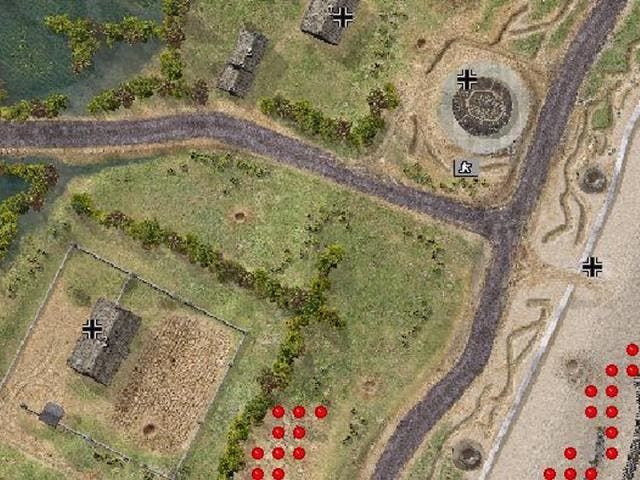
Come Hell Or High Water
The Cotentin Peninsula is an inspired choice of setting. The 44 maps offer a great deal of variety, from the initial invasion beaches and glider landing fields to the villages and hedgerows of the hinterland, ending with the attack on Fort Roux and Cherbourg at the tip of the peninsula. There are churches and orchards, bunkers and bridges, sea walls and hangars. By far the most dominant feature though is the dreaded bocage, which consists of ancient earth banks with hedgerows on top. It offers great defensive opportunities, hampers the movement of armour, shields the movement of infantry and offers numerous ambush points. Tanks crossing the bocage may leave a crush of branches behind, or they may throw a track. Infantry crossing an open field may find themselves under withering short-range fire from an enemy machinegun concealed in a nearby hedge. Above all, the close nature of the terrain brings good combined arms tactics to the fore; the days when you could send tanks off on their own across the Russian plains in Close Combat III are long gone.
The initial attacks actually preceded the beach landings - the US 82nd and 101st Airborne Divisions landed by glider and parachuted in the enemy rear the night before D-Day. Here they will have to hold the areas immediately behind the beaches from German counter-attacks, but light infantry have their limitations, as you will realise the moment your troops are faced by a German armoured vehicle. There is not much rifles can do against a tank and bazooka teams will be a prime target for enemy machineguns. The rest of the Americans landed the conventional way, off landing craft, up a beach strewn with barbed wire and anti-tank obstacles and littered with mines. While the first troops ashore are of medium to good quality, some of the following units are pretty green. These will require all their heavy weapons if they are to make much impact on the better German troops, though their mortar halftracks and heavy machineguns should even the odds a bit.
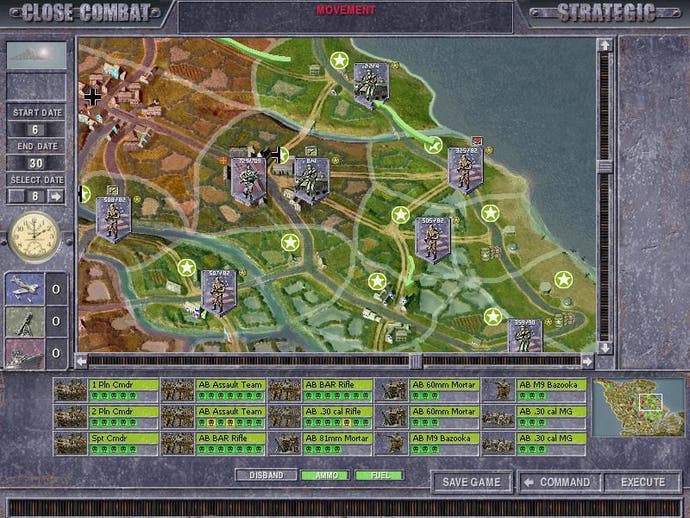
The Bigger Picture
Invasion Normandy offers battles in three sizes - individual struggles for beaches or villages, operations involving three or four linked battles (such as the airborne landings of the 82nd Airborne Division, or the defence of Cherbourg by Kampfgruppe Mueller) and four larger campaigns including the initial airborne strike and the attack on Cherbourg.
Operations and campaigns add another layer to the traditional Close Combat gameplay and you can move your regiments around a map of the Cotentin in a manner similar to that found in the last Close Combat game, the Battle of the Bulge. The system is clear and simple, offering one significant improvement over the last installment - a degree of tailoring of your combat units is now possible; indeed to cope with the changing offensive and defensive situations it is absolutely necessary.
Close Combat III offered a points system that allowed the successful player to put together a force of his choosing with few practical restrictions. This led to unrealistic armour-heavy Kampfgrueppe wiping the steppes of an enemy who had no such freedom. Its sequel went to an opposite extreme - you took the hand you were dealt. Invasion Normandy offers a third way - each regiment has a restricted pool of units available, allowing you to add a Sherman tank here, an 81mm mortar there. However, these additions are limited, with only one reinforcement of each regiment allowed per campaign. If you lose your contingent of flamethrowing tanks in your first beach assault, you will miss them sorely a few days later in the hedgerows. The Germans have a similar problem, although for them it is perhaps wiser to commit resources earlier, while the opposition consists of lightly-armed paratroopers and infantry on open beaches. If you can hold or retake one of the two invasion beach maps, you will put a powerful brake on American expansion.
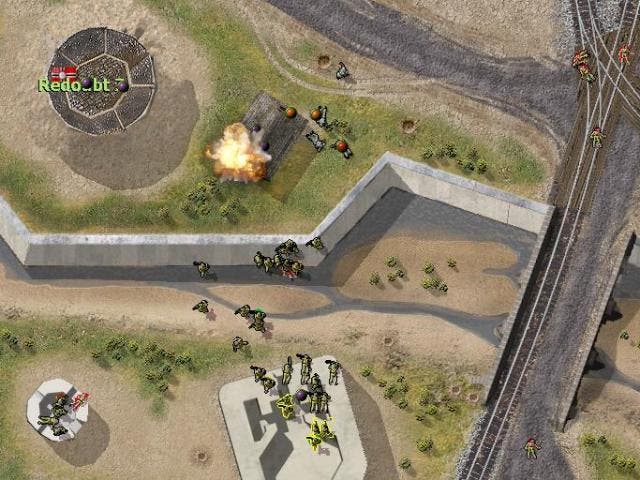
Battlefield Normandy
The battles themselves are extraordinarily good, a marked improvement over the last Close Combat game, and even better than some of the magical battles on the Russian Front. To an overwhelming degree this is due to map design, and the sheer variety and size offer a richness of experience not found in other games. In one battle your paratroopers will be struggling to capture the only bridge that will let your armour break out of the flooded fields behind the beaches, in another you will be capturing a small town, fighting hand-to-hand in the houses, while in the third you will be assaulting a major fortification and bunker system.
The AI will mount an active, probing defence that keeps you on your toes, and your BAR team heading down the hedgerow may well be met by some Grenadiere crawling the other way. Leave one flank uncovered as you attack and you may find an enemy machinegun set up in that church steeple before you know it. On attack the enemy will concentrate his forces, moving from objective to objective until you can muster a solid defence. The close ground prevents the use of overlapping fields of fire, so you will need to put machineguns on the top floor of every tall building you can find if you are to offer any support to the squad in the next farm.
There are easy kills to be had at the beginning of the battle as you spot the enemy running across an open field, but once you have given away your position by firing the picture changes and your building will be stormed by determined soldiers supported by heavy machinegun fire and masked by smoke grenades. All of this encourages the player to use proper military tactics, with the AI generally doing a good job here too - tanks are supported by infantry very well, hampering close assaults and ambushes. In one battle my Sturmgrenadiere were only able to destroy a Sherman ten yards from their hedge when its three supporting squads had been decimated by machinegun fire and suppressed by an intense mortar bombardment.
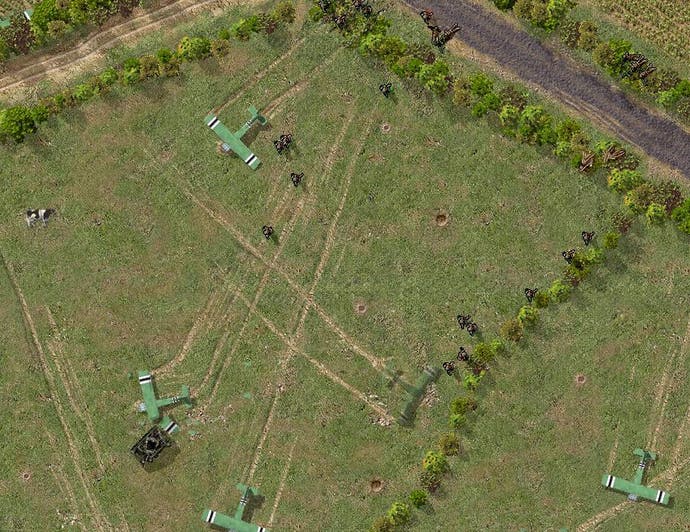
More Than Skin Deep
The artwork and sounds for Invasion Normandy are also outstanding, which is all the more remarkable given the relatively low system specifications the game will run on. The little troops run, crawl and reload their rifles, and there is beauty in the puff of orange smoke calling in an airstrike, or the flashes and clouds from a naval barrage. Flamethrowers look appropriately devastating, as demonstrated by the sheet of orange flame and the charred corpses left behind.
The game does not have a complex graphics engine; it has changed little since its third inception, which is why it runs as well as it does. The downside is seen in the functional dotted lines that indicate machinegun fire, the static water and other features. This game lives or dies on its gameplay though, and you don't even notice the odd indication that this is still a 2D game as the attention to detail is breathtaking. The little gaps in the hedgerow you can squeeze a tank through, the sunken ship in Cherbourg, the crashed gliders leaving furrows in the fields, the dead cows... Yes, one of the abiding recollections of those who fought in Normandy is the smell of dead and bloated livestock. Thankfully that is not an experience which Atomic can accurately convey.
The battle effects are persistent and a building destroyed in one battle will still be destroyed in the next. That burnt-out tank blocking the road will still be there as well, along with the shell-holes in the field. For a campaign involving 44 maps that is nothing short of remarkable. The sound also builds on the excellent tradition of the Close Combat series. The voice cues are spot on and the troops sound as though they are in a battle rather than on the high street. Weapon sounds are equally good, from the roar of the Sherman's main gun to the weaker pop of the 37mm guns of the French tanks, and the saw rasp of the MG34 contrasting with the thump-thump-thump of the Browning .50 cal. Ambient sound is probably the biggest single improvement over other titles in the series though, with birdsong replaced by distant machinegun fire and sounds of battle.
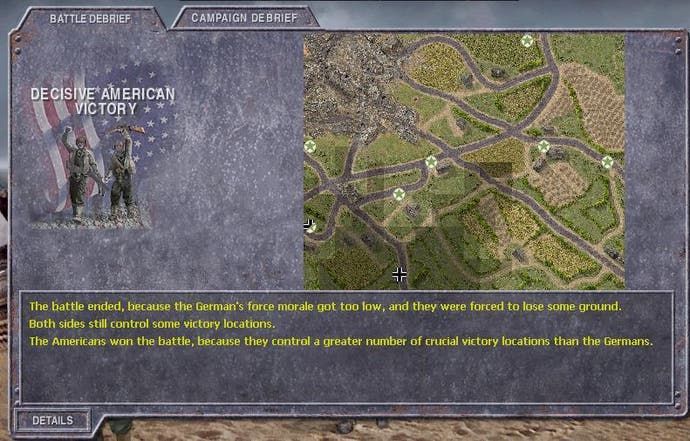
Conclusion
Sadly, in a move of suicidal incompetence, the European distributors of the game added a copy protection system which left the first batch of CDs inoperable, disappointing many fans who had been eagerly awaiting its release.
But now that this problem has been remedied Close Combat : Invasion Normandy is unquestionably a triumph, marking a great improvement over the last game, which met with a rather mixed response. It relies on gameplay rather than on cutscenes and ephemera, and the variety and suspense of individual battles combined with the simple but effective campaign system mean that it will stay on a good many hard disks for a long time to come.
It's not without its flaws. The lack of the old Battlemaker mission editor is disappointing, the top-down viewpoint makes judging the terrain's elevation by sight difficult at best and the removal of most of the concealment attributes of anti-tank and infantry guns makes them far less effective than in Close Combat III. But overall this is an excellent return to form for the long-running series.
